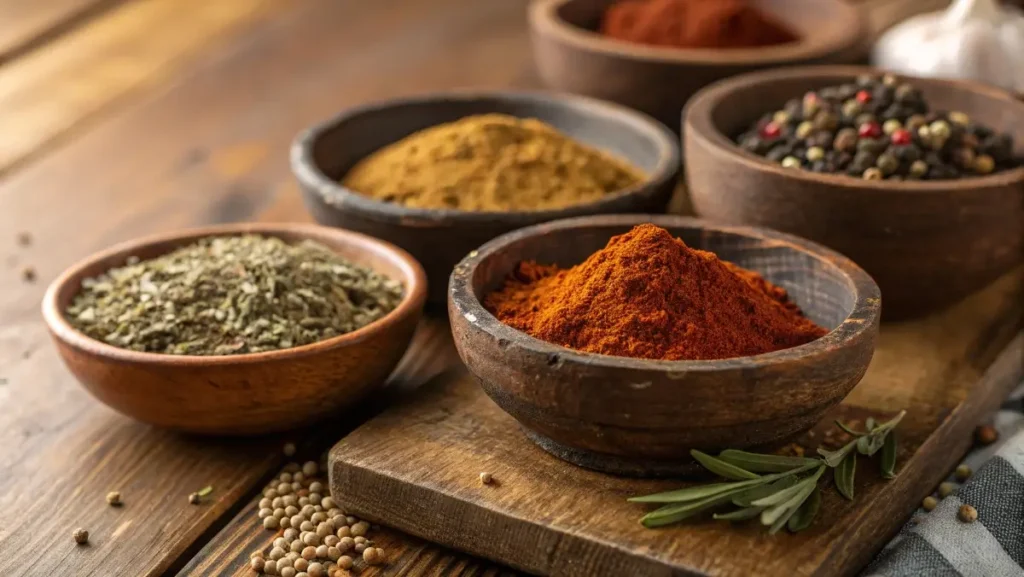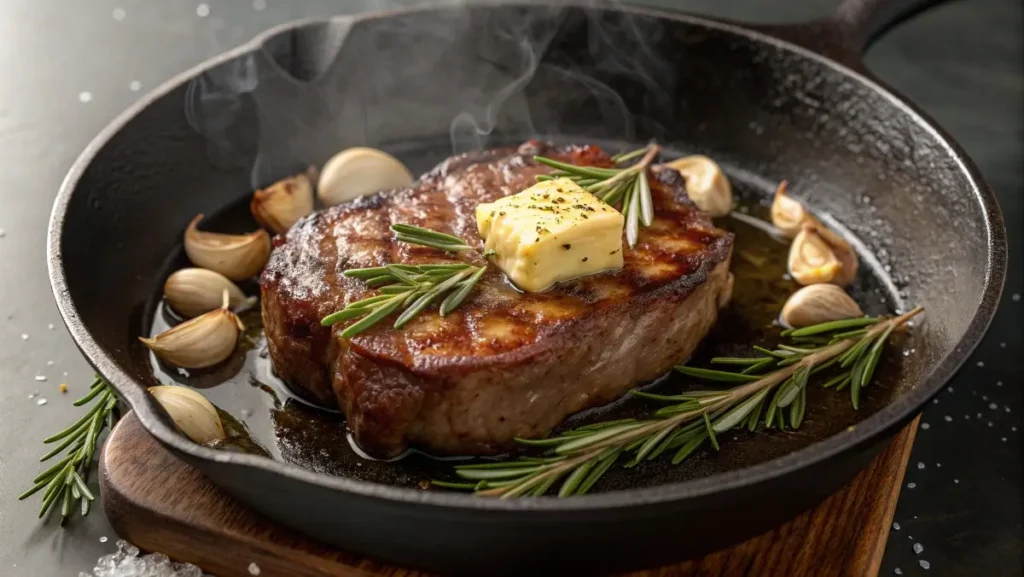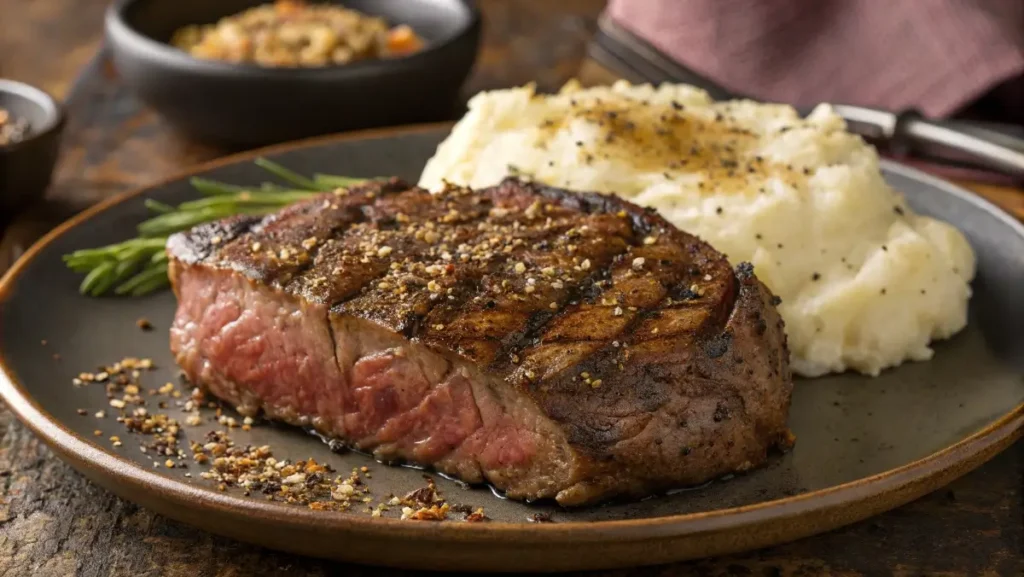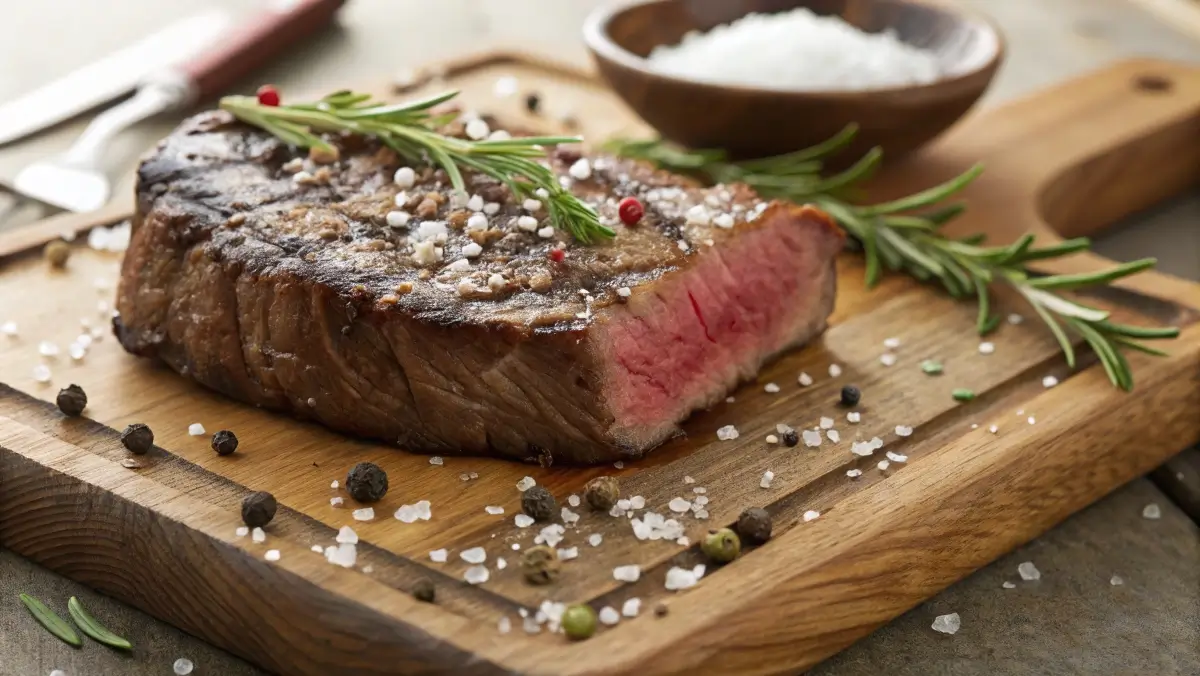Steak Seasoning Recipe: The Ultimate Guide to Flavorful Steaks
Seasoning a steak is more than just adding a pinch of salt — it’s an art that turns a simple cut of beef into a masterpiece. The right blend of spices can transform an ordinary steak into a melt-in-your-mouth, flavor-packed experience.
In this guide, we’ll break down the best steak seasoning recipe options, explore chef-inspired blends, uncover the 3-3-3 steak cooking rule, and even give you a Texas Roadhouse copycat mix you can try at home. Whether you prefer your steak grilled, pan-seared, or smoked, you’ll learn how to season it like a pro while avoiding common mistakes.
And if you’re looking for the perfect comfort dish to pair with your steak, check out our crockpot loaded steak and potato bake for the ultimate meaty sidekick.
Table of Contents
Understanding the Art of Steak Seasoning
Why Seasoning Matters for Steak Flavor
Seasoning is the bridge between raw meat and a restaurant-quality dish. The natural taste of beef is rich and savory, but without seasoning, it can fall flat. Salt, in particular, plays a huge role in unlocking the meat’s flavor. When sprinkled over steak, it draws out moisture, creating a brine that soaks back into the meat — carrying flavor deep inside. Pepper adds a sharp, aromatic kick, while herbs and spices layer in complexity. A well-seasoned steak excites the taste buds from the first bite to the last.
How Seasoning Affects Texture and Juiciness
Good seasoning doesn’t just affect taste — it changes how the steak feels in your mouth. Salt tenderizes the surface, helping to create that crave-worthy crust when seared at high heat. Meanwhile, spices like paprika, garlic powder, or onion powder form a flavorful bark that locks in juices. When combined with proper cooking techniques, seasoning ensures a steak stays tender, moist, and bursting with flavor. Think of it as the secret handshake between chef and diner — the little touch that says, “You’re about to eat something special.”
The Best Seasoning for a Steak – Chef’s Picks
Classic Salt and Pepper Method
Ask any seasoned chef, and they’ll tell you that the best steak seasoning recipe often starts with simplicity. A high-quality coarse kosher salt and freshly cracked black pepper are all you need to let the steak’s natural flavors shine. The coarse salt penetrates the meat, enhancing juiciness, while black pepper brings a subtle heat that complements the beef’s richness. For optimal results, season generously at least 40 minutes before cooking to allow the salt to draw out and reabsorb the meat’s natural juices.
Signature Chef Blends for Steaks
While the salt-and-pepper combo is timeless, many chefs elevate their steak seasoning with unique blends. Gordon Ramsay, for example, often adds garlic powder, smoked paprika, and a touch of cayenne for depth and warmth. Other professionals use a mix of rosemary, thyme, and sea salt for a fresh, aromatic finish. Experimenting with these blends at home can give you that upscale steakhouse flavor without leaving your kitchen. Don’t be afraid to customize — some of the best steak seasoning recipes are born from a pinch of creativity and a dash of boldness.
Popular Seasonings That Go Well with Steak

Herbs and Spices That Complement Beef
While salt and pepper form the backbone of any great steak seasoning recipe, a variety of herbs and spices can elevate your dish to the next level. Garlic powder and onion powder add savory depth, paprika lends a subtle smokiness, and cayenne pepper introduces a gentle heat. Fresh or dried rosemary and thyme bring a fragrant, earthy quality that pairs beautifully with the richness of beef. For a bolder twist, try coriander seeds, cumin, or mustard powder — each adds a unique character to the flavor profile without overpowering the meat.
Bold Flavors vs. Subtle Notes
The choice between bold and subtle seasoning comes down to personal preference and the cut of steak you’re cooking. Ribeye, with its marbling, can handle more robust seasonings like chili powder, coffee rubs, or smoky BBQ blends. On the other hand, leaner cuts such as filet mignon benefit from more delicate touches — think white pepper, fresh parsley, and a squeeze of lemon zest. Balancing flavors is key: strong spices should enhance, not mask, the steak’s natural savoriness.
For smoky inspiration, you can take cues from our smoked chuck roast recipe to infuse deep, outdoor-grill aromas into your steak.
The 3-3-3 Rule for Steaks Explained
What the 3-3-3 Cooking Method Means
The 3-3-3 rule is a simple cooking guideline that ensures your steak cooks evenly while developing a flavorful crust. It means you sear the steak for three minutes on one side, three minutes on the other, and then three minutes in a lower heat zone or oven to finish cooking. This method works especially well for medium-rare steaks, giving the exterior a caramelized, seasoned crust while keeping the inside tender and juicy. It’s a straightforward approach that even beginner cooks can master.
How It Impacts Seasoning and Flavor
Timing is everything when applying the 3-3-3 rule. Seasoning should be applied well before cooking so it has time to penetrate the meat. When the steak hits the hot surface for that first three-minute sear, the salt and spices instantly form a crust, locking in juices. The second sear builds even more flavor, while the final three-minute finish ensures the seasoning has melded into every bite. For those who love smoky undertones, try adapting the rule on a grill inspired by our grilled hanger steak technique for extra depth.
What Gives Steak the Best Flavor

High-Heat Searing and Seasoning
The foundation of a flavorful steak lies in the Maillard reaction — that beautiful browning that occurs when meat meets high heat. Searing your steak at a high temperature creates a caramelized crust that locks in juices and intensifies the flavor of your steak seasoning recipe. Whether you use a cast iron skillet, grill, or broiler, aim for an initial burst of heat before lowering the temperature to finish cooking. This method ensures your seasoning not only sits on the surface but also bonds with the crust for maximum taste.
The Role of Resting Time After Cooking
Even the best seasoning won’t shine if the steak’s juices run out too soon. Resting your steak for 5–10 minutes after cooking allows the juices — and the seasoning-infused flavors — to redistribute throughout the meat. Cutting into a steak too early can cause those precious juices to spill out onto the plate instead of staying in each bite. For a meal that’s as visually impressive as it is flavorful, pair your rested steak with a bold side dish like our picanha steak served with chimichurri for an irresistible combination.
What Chefs Use to Season Steak
The Professional Kitchen Approach
In professional kitchens, chefs often stick to tried-and-true methods when crafting the perfect steak seasoning recipe. The base usually starts with coarse kosher salt and freshly cracked black pepper. From there, many add layers of flavor with garlic powder, onion powder, smoked paprika, or chili flakes. The key is consistency in seasoning — ensuring every inch of the steak is coated evenly for balanced taste in every bite. Chefs also season from a height of about 12 inches, allowing the salt and spices to spread more uniformly over the meat’s surface.
Special Ingredients for Signature Flavors
Beyond the basics, chefs often use special touches to make their steaks stand out. Some brush steaks with melted herb butter infused with rosemary and thyme before serving. Others sprinkle a dash of finishing salt like Maldon sea salt just before plating to add a delicate crunch. Certain steakhouse favorites even incorporate coffee grounds, cocoa powder, or dry mustard for an unexpected but delightful twist. If you want to experiment, draw inspiration from our Steak Tartare recipe, which balances richness and seasoning for a restaurant-worthy experience at home.
Texas Roadhouse Steak Seasoning Copycat Recipe
Breaking Down the Flavor Profile
Texas Roadhouse is famous for its boldly seasoned steaks that balance savory, smoky, and slightly sweet notes. Their seasoning blend leans heavily on coarse salt and black pepper, but also incorporates garlic powder, onion powder, and paprika for warmth. Hints of brown sugar bring subtle caramelization during searing, while chili powder adds just enough heat to keep things interesting. The result is a robust crust that enhances — rather than masks — the natural beefy flavor.

DIY Texas Roadhouse Seasoning Recipe
Here’s a home-friendly version inspired by the Texas Roadhouse steak seasoning recipe:
| Ingredient | Amount |
|---|---|
| Kosher salt | 2 tbsp |
| Coarse black pepper | 2 tbsp |
| Paprika | 1 tbsp |
| Garlic powder | 1 tbsp |
| Onion powder | 1 tbsp |
| Brown sugar | 1 tsp |
| Chili powder | 1 tsp |
| Smoked paprika (opt.) | ½ tsp |
Mix all ingredients thoroughly and store in an airtight container. Generously season both sides of your steak at least 40 minutes before cooking, allowing the blend to penetrate the meat for deeper flavor. For a perfect pairing, consider serving alongside our Parmesan Smashed Potatoes for a true steakhouse-style meal.
Conclusion & Final Tips
Mastering a steak seasoning recipe is less about following rigid rules and more about understanding flavor balance and cooking technique. Whether you’re a fan of the simple salt-and-pepper approach or prefer a bold Texas Roadhouse-style blend, the key is to let the seasoning enhance the natural richness of the beef. Apply your spices early, sear over high heat, and give your steak a proper rest before slicing — these small steps make a big difference in taste and tenderness.
Experiment with different herbs, spices, and cooking methods to discover your personal favorite. And remember, the right side dishes can elevate the entire dining experience. For inspiration on pairing options, don’t miss our Delicious Meatballs With Grape Jelly and BBQ Sauce for ideas that complement your perfectly seasoned steak.
FAQs
What is the best seasoning for a steak?
The best seasoning for a steak depends on personal taste, but most chefs agree that coarse kosher salt and freshly ground black pepper are unbeatable for enhancing natural beef flavor. From there, you can build with garlic powder, paprika, or rosemary to match your preference.
What seasonings go well with a steak?
Steak pairs well with both earthy and bold seasonings. Favorites include rosemary, thyme, garlic powder, onion powder, paprika, and cayenne. Smoked paprika adds a rich, savory depth, while fresh herbs brighten the flavor.
What is the 3-3-3 rule for steaks?
This method involves cooking the steak for three minutes on one side, three minutes on the other, and three minutes in a lower heat zone or oven to finish. It creates a seared crust while keeping the inside tender and juicy.
What gives steak the best flavor?
High-heat searing for the Maillard reaction, generous pre-seasoning, and proper resting time all contribute to a flavorful steak. Using quality cuts and fresh spices also makes a significant difference.
What do chefs use to season steak?
Chefs rely on salt and pepper as a base, then layer in garlic powder, smoked paprika, or fresh herbs. Many finish steaks with herb-infused butter or a sprinkle of flaky sea salt before serving.
What does Texas Roadhouse season their steaks with?
They use a bold blend of salt, pepper, garlic powder, onion powder, paprika, chili powder, and a hint of brown sugar. This mix creates a signature crust that balances savory, smoky, and slightly sweet flavors.

